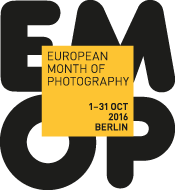Education Workshops
>> C/O Berlin Education, Hardenbergstr 19, 10623 Berlin
>> Sat 1 Oct
>> Free admission • No registration
>> Age 8-14 Years

SATURDAY 1 OCT
12–3 pm, 3–6 pm
EYE FOR AN EYE, HOLE FOR A HOLE
PHOTO PROJECT WITH GIANT PINHOLE CAMERAS
Georgia Krawiec, Photoartist
Can we really take pictures without timers, flash, and lens? The ancestor of all cameras makes it possible—the pinhole camera. Its structure is ver y simple because it consists of only three parts: lightproof housing, small round opening, and light-sensitive material. But you can’t take this camera to the photoshop for quick processing. A darkroom is necessary, as well as developers and fixers. What looks like unnecessary work at first is actually a lot of fun. Because this way, you can create your own photo from the ver y start to finish. Something truly unique! The workshop consists of two parts: The artist Georgia Krawiec is setting up large format pinhole cameras at C/O Berlin, which ever yone can use to take a portrait of themselves. After this exposure period, you can simply head to your own home photo lab to develop. At the end, everyone can take their pictures home with them.
12–2 pm, 3–5 pm
LIGHT GRAFFITI
EXPOSURE EXPERIMENTS IN THE DARKROOM
Eva Gjaltema, Photographer
Light is fast, light is fleeting. Graffiti, however, is composed of static elements like images, logos or signs on a solid surface. Howcan we combine the two? How can you fix a moving tracer? The photographic medium makes that possible. The dynamics of light is a popular topic in photography that reaches far back into photographic history. Artists like László Moholy-Nagy, Otto Steinert, Pim van Os and Pablo Picasso practiced light experiments and produced surreal images with the help of simple light sources. The light magic is examined more closely in the workshop and captured in images. After a short introduction to light photography, the participants will immerse themselves in darkened rooms in order to paint figures, shapes and lettering in the darkness with different lights like flashlights or glow sticks and to create combined magical images.
12 pm, 13 pm, 14 pm, 15 pm, 16 pm, 17 pm
THE WAY OF THINGS
PHOTO EXPERIMENTS WITH MOVING OBJECTS
Katrin Wittig, Scenographer
Everyone becomes a researcher in order to use the influence of physical forces like centrifugal force, thrust or magnetism and make things run that they’ve made themselves. The photographic medium is perfectly suited for documentation. After a short introduction into the world of dynamics, the participants choose a physical phenomenon that they would like to research. They sketch the respective movement and its sequence and use fitting objects made of wood, wire, cardboard, paper, string, fabrics, modeling materials or dough to create the experiment set-up. After that, they enter a darkened room where they can perform different experiments on the movement of objects and ar tificial light. At the end of the workshop, ever y par ticipant has a fun visualization of the respective dynamic type as part of a small photo series.
12–2 pm, 2–4 pm, 4–6 pm
DECOLLAGE
DISCOVERY OF NE W IMAGERY
Frederik Poppe, Visual Artist
Often we see billboards in the streets of Berlin plastered thick with posters. Not only with a layer but rather with countless layers of paper. Before tearing down the entire block, we can change it in an artistic way. Just like the artist Wolf Vostell, who has perfected the method of décollage. The workshop participants will reveal hidden works of art by ripping, burning and cutting the boards in front of Amerika Haus. With tools or bare hands, the participants expose the top layers of the billboards and search for exciting intermediary layers and hidden visual contexts. A photo camera will be installed to document and automatically take shots at regular intervals. A time-lapse film is the result and it records the entire décollage process—another visual product of the workshop.
12 pm, 1 pm, 2 pm, 3 pm, 4 pm, 5 pm
ANIMATED WORLDS
INSIGHTS INTO THE WORKSHOP OF THE ANIMATED FILMMAKER
Jan Caspers, Puppeteer and Animator
Wild goblins climbing the T V Tower, whistling dogs riding bikes through the Tiergarten, tiny Martians landing on the dome of the Reichstag, a colorful horde of goblins dancing down the Ku’damm—something that only happens in a dream. But how can these amusing thoughts be brought to life? Animated films make ever ything possible that your imagination can come up with. You can create your own world just the way you want it. In this workshop, par ticipants receive an introduction to different stop-motion techniques such as claymation from experienced animator Jan Caspers. At the end, they receive the oppor tunity to design their own character and develop a short stor y. With the help of cameras and computer programs, they can bring their animated figures to life - by hand and step-by-step.
